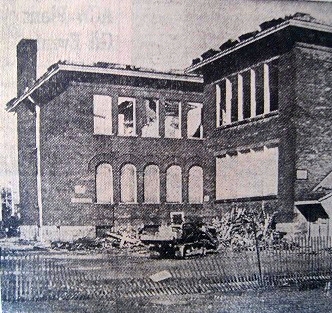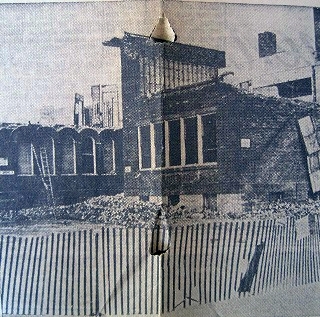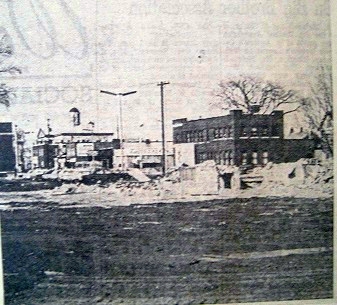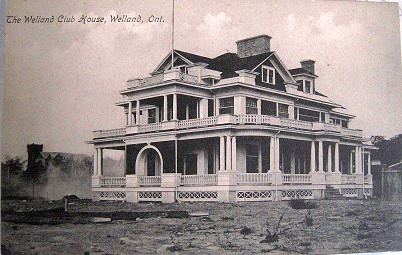Leaving Many Sorrowing Creditors
[Welland Tribune, 22 January 1909]
“H.J. Griffiths, sanitary plumbing, gas, steam and hot water heating.”
Such is the story told in the letters of gilt on the window.
But upstairs the blinds are drawn, and downstairs the doors are locked, and the gas stoves and pipes inside refuse to give any information.
It was not long ago that H.J. Griffiths arrived first in Welland.
He was a good plumber, and knew all the ins and outs of that highly lucrative business.
Mr. Griffiths learned his trade with that old-timer Peter McMurray and consequently when he hung out his shingle on his own hook in the East Main street store about a year and a half ago, he had a connection established.
His specialty was bath and closet work, and the installation of heating appliances in up-to-date homes.
With him were associated as employees D. Flick, Leo White and Ernest Peart, to whom he owes, it is alleged $18, $6 and $30 respectively.
Sam Beattie is also a little anxious as to when his $5.00 loaned is coming back, and Ed Hughes would be pleased to have the settlement of a grocery bill.
But these are only trivial things.’
The James Robertson Company of Toronto are anxious over a bill of $675, while the Dominion Radiator Company, also of Toronto, would be pleased to have a settlement of a $500 account coming to them. Then there is the Jas. Morrison Brass Mfg. Company of Toronto, whose interests in the departed Mr. Griffiths, cannot be learned.
However, the Dominion Radiator Company got in first, and the sheriff is in charge, and the key is in the county safe.
Mac Hill is also interested in Mr. Griffiths to the extent of $150, but Mr. Hill was not born yesterday, as his friends know, and there will be no loss in that quarter.
Charles Stewart, who has the shoe repair shop, just around the corner, was Mr. Griffith’s landlord.
He has little kick coming.
There is a contra account.
“Griffiths is a good fellow, and I’m sorry he went,” was the high constable’s comment between stitches.
The manner of his going was strange.
Mrs. Griffiths and a box and trunk went on the G.T.R. to Merritton, and Mr. Griffiths went on Saturday afternoon to Bridgeburg.
Some clothing was left in the home, some waists, and a pair of skates and boots attached. The furniture is there.
Mr. Griffiths has gone.
He had the sub-contract for the plumbing work in the hospital, and on Saturday called at Mr. Peacock’s to get some money, but Mr. Peacock was in Port Hope.
He dealt with the Imperial Bank here, and a few days before he left, made a deposit.
Mr. Griffiths, in his going, so far as can be learned, so far has done nothing to flee the country.
Business reverses seem to be the cause.
A few days before that he received a black eye as the result of a scrap with a fellow plumber, but he was not a bad fellow.
It is understood and alleged that he was given to the sport of kings and followed the bang tales, and had been known to set into a game as get mellow with the stuff that sparkles.
To be plain, Mr. Griffiths played poker, not wisely, not too well, bet on the races and drank whiskey. He did an excellent business, and there was no reason, had he attended to it, why he should not have succeeded in a large way. His card playing was an expensive fad. On one occasion at the Hamilton races, it is alleged that a wandering fellow, with nimble brain and fingers, took away from him $100 at one sitting.
However, there is no proof that he was dishonest, and perhaps someday he will return and surprise the knockers, and the members of the anvil chorus who are saying, “I told you so.”
Mac Hill and P. McMurray were appointed stock takers by Sheriff Smith. The stock will amount to about $1,000.
The Registrations of Over a Century
[People’s Press, 25 January 1910]
Many years ago, as they say in the story books, the Puritan fathers rebelled against the Mother-land and took up arms against her.
England was busy then, very busy in other parts of the world, for nations grim-visaged and experts in the art of war anywhere, and to protect our frontier and it was not much of a frontier then, and to aid in subduing her unruly children, Butler’s Rangers took a prominent part.
That was a stormy period.
When the war was over, or rather when the revolution ceased, and independence was granted, Butler’s troops disbanded.
They liked Canada, liked it so well that they asked for land grants and received them from the Crown.
It is a far, far call from 1796 to 1910, one hundred and fourteen years, yet in that red brick stone pile beneath the shadow of the Welland county court house, in the registry office, are the records of property transferred in that long ago.
If those deeds and books lying tier upon tier could only speak, they would tell strange tales of sales and transfers and foreclosures, but there they are, containing over 100,000 instruments, representing many millions in money and years of toil. Hundreds of thousands of people have been directly and indirectly interested in these deeds.
Through the courtesy of J.C. Crow, the obliging registrar, a Press representative was last week given a peep behind the scenes, for even an austere and prosaic business like the keeping of the deeds in a registry office has its mystic side.
Mr. Crow held up a blue paper carefully folded.
It was a deed, dated 22nd June 1796, nine o’clock.
“The ink is as clear as though it were written yesterday,” the writer observed.
“Read on,” replied Mr. Crow.
“I certify that this is a true copy. The original is not in existence.”
John Powell, registrar, Lincoln.
Then Mr. Crow went back into history.
In the war of 1812, when Uncle Sam was ambitious, she fired hot shot at Niagara, and the registry office was destroyed, with many records. This took place on Dec. 10, 1813. However, not all of the books went up in smoke, and between the books saved and records preserved, copies were made and certified to, similar to the one exhibited by the registrar.
To this double system the preservation is owed, and today throughout Ontario each deed is copied in a book, and in the registry office in Welland, besides being in a fire proof building, the two wings are separate, in one are the books, in the other wing the records.
Fire could not reach them.
The town of Welland, old to the oldest of us living, is not old in comparative history, neither is the county.
In all the eight townships comprising the county settlement was begun at least twenty years prior to the year 1800.
And in this connection the following list will be most interesting.
FIRST DOCUMENTS
Here is a list of the first documents registered in each of the townships in which Welland county was afterwards composed.
BERTIE
A deed poll registered 22nd June 1796, as No. 9 from John Maybee, “of a place commonly called Chippawa Township in the county of Lincoln and Province of Upper Canada,” to Nathan Raymond of Bertie, of Lincoln aforesaid, of lot 9 in the Twp. of Bertie aforesaid “lying in the front on Niagara river, nearly opposite the south end of Grand Island, 120 acres more or less,” for a consideration of 21 pounds, 5 shillings. This land lies immediately north of the present municipality of Bridgeburg.
CROWLAND
A deed registered 6th January 1798 (as No. 37) from Daniel Hazen to James Macklem, of lands in the Tp. of Crowland, county of Lincoln, described as lots 4, 5, 6 and 7, in 1st con., 460 acres, “Situate on the River Welland, about 4 miles from its mouth.”
HUMBERSTONE
A deed (No. 30) registered 22nd Sept. 1798 from Thomas Welch to Christian Zavitz, part lot 33, con. 1 in Tp. Humberstone, county of Lincoln, 204 acres. This land is the very southwest part of Humberstone Tp., and is the farm on which Sugar Loaf Hill is situate.
PELHAM
A deed registered 10th March 1798, (No. 34) from James Austin of the town of Newark to Haggai Skinner of Pelham, in the county of Lincoln of lot 6, con. 14, 186 acres. This is the farm at Reilly’s Bridge now owned by John H. Cosby and Alexander Eastman.
STAMFORD
A lease from John Burch to Benjamin Hardison and John Fanning of lots 191, 192, 193, 223 and 224 and broken front of 191 and 192 in Tp. Stamford Co. of Lincoln, 370 acres, registered 18th Sept. 1796 as No. 8. That part of Chippawa village on north side of Welland river is situate upon these lands.
THOROLD TP.
Deed registered, September 1798(No. 31) from Thomas Welch to Martin Mitchell, of lots———and is now owned by Wm. H. Willson.
WAINFLEET
A deed registered as No. 31 on 22nd August, 1797, from Edward Burk of the town of Queenston in the township of Newark Co., of Lincoln, in the Home district of Newark Co. of the Province of Upper Canada to John McKay of the town and township of Newark, 200 acres described as lot 24 on the Welland river in Tp. Wainfleet, Co. Lincoln. This property is situate about midway between Beckett’s Bridge and Candasville, and is John___and Jacob Chambers, respectively.
WILLOUGHBY
A deed from Thomas Cummings of the Tp. Of Willoughby, Co. of Lincoln, to James Macklem of Tp. of Stamford in Lincoln Co., a lot containing forty parcels situate on the N.E. Side and near the mouth of the Chippawa creek, registered 13th July 1796, as No. 5. This of course would be at what is now Chippawa village.
SETTLEMENT BEGUN
The numbers given these eight instruments would indicate that one series of numbers was used for the whole county or, more likely, for the whole Niagara district, which at that time was one registry division with municipal offices located at Old Niagara.
The dates of these several registrations being so close together, three of them in 1796, one in 1797 and four in 1798, would indicate that permanent settlement began throughout the county at about the same time. It is also interesting to note that all of these deeds name the township but none of them say “Welland Co.” This shows that the townships had been surveyed and named prior to the year 1800, and it is a known fact that the townships were organized for municipal purposes in the very beginning of the 19th century. The word “Welland” is not found in any registered instrument till about the year 1849, which is about the time a provisional council was granted to Welland county.
And so the Niagara peninsula gradually took shape, the forest was gradually cleared, and in 1817 the population was nearly 6,000 souls.
The year 1841 found Niagara District Council organized with a district registry office and court house.
But this was not satisfactory to some of the pioneers, and after an agitation for separation for nine or ten years, an act was passed in August 2nd 1851, and a provisional municipal council was given Welland, and the registry office opened in 1852 by D. D’Everardo at Fonthill.
The final act of separation of Lincoln and Welland passed on April 31st, 1856 and the proclamation setting Welland apart, was read on May 12, 1856.
And then arose internal dissension.
ALL ABOUT THE COURT HOUSE
Where would the court hose be? To what place would be the proud distinction of having the title county seat?
MR. ELLIOT’S MEMORY
The first instrument registered by Registrar D’Everardo was to the provisional municipal council of Welland, from Donald McFarland, Port Robinson, and John Donaldson of Oneida, Haldimand county.
The instrument was transferring the site upon which the Welland court house now stands.
The second instrument was a site for Port Robinson from John Ramsden, Humberstone, father of the present ex-reeve.
They were very much in earnest over having the county seat in Port Robinson, and a few of the ardent spirits raised money to buy the land. The ardor continued, and George Elliot, the deputy registrar remembers the day, a cold and stormy one, when amid ardor increased (to keep out the cold) the corner stone was laid. But the property was deeded back after the court house was erected in Welland.
OTHERS ENVIOUS
But other places besides Port Robinson wanted to be called “The Capital.”
There was Cook’s Mills.
“We are the centre of the county,” they called in unison.
There was Fonthill.
“We are beautiful for site and elevation,” they called.
But Merrittville it was, Welland it is and shall be.
REGISTRY OFFICE COMES HERE
However, the registry office remained in Fonthill for several years, but one day, in the year 1871, a real live agitation arose in the county council and the pleasing little village of Fonthill lost its registry office, and in the autumn of 1872, the records were removed to Welland.
In the court house was where they kept the instruments for eight years, but in the year 1880 the then sufficiently commodious structure was erected.
THOSE IN POSITION
And who held the seats of the mighty in thee olden days when the court house first reared its head. The first sheriff was Robert Hobson, in 1856, and the first judge, His Honor H.W. Price, in the same year. D. D’Everardo was a busy man, on him devolved the duties of registrar clerk of the Surrogate Court, and county clerk, L.D. Raymond, the father of L.C. Raymond , K.C., acted a clerk of the peace.
THE FIRST BOOK
Registrar D. D’Everado opened his first book on March 11, 1852..
It was but 11 columns.
The registrars in Welland county: Mr. D’D’Everardo who died on July 28, 1891; Col. Morin who was called by death on Oct. 6, 1892 and the present registrar J.C. Crow.
A FEW FIGURES
Figures are dry things and only supposed to be used at political meetings, bank meetings, and when raising money for the church, but in this case it is pleasing to note that Welland’s growth and the county’s awakening is told in the following figures.
Tabulating the business thus shown to have passed through the hands of the three incumbents of the office, we find the total number of registered instruments in the office to be as follows:
Mr. D.”Everardo-
From March 11, 1852 to Dec. 30, 1865…..14,292.
From January 1866 to July 1891, ………..50,903.
Total in a little over 39 years,…… 65,195 (Or about 1650 per year).
Col. Morin, From July 1891 to Oct. 1892 in about 11 ½ years…24,148 (Or about 2150 per year).
Mr. Crow-to Dec. 31 1909
A little over seven years ..25,065 (Or over 3450 per year.}
Total documents registered since Welland office opened in 1852…114,408
Add documents registered in Niagara and Lincoln, prior to 1852, and now on file here (estimated at)…10,000.
And a total of ….124,408.
Instruments are found in the Welland office.
These figures reveal the continuous and always interesting volume of business done in the office. Mr. D’Everardo, in his last 25 years registered but 1690 more instruments, than did Col. Morin and Mrs. Crow, in the next 18 years, and Mr. Crow in the past seven years did 917 more registrations than were done by Col. Morin in the preceding 11 years.
A BUSY MAN
“You are a busy man.”
“Yes…we are busy in here now,” replied the registrar.
“Come in here.”
The Press representative followed. Here tier upon tier were books.
“Come over here.”
Here was tier upon tier of tins-the technical word is not forthcoming.
“Millions of dollars are held on record here?”
“Millions,” was the reply. “One mortgage for over four million dollars is registered here.”
“Many thousands are interested in the contents of this building.”
“I should say so.”
The east room has 480 shelves, out of which the books come on roller bearings. There are 480 shelves and 435 books, and the number growing steadily.
“Where do the other books go? Where do books go that have no fitting place?
In short, Registrar Crow is badly crowed for room.
Under one counter drawer are stuffed 322 plans.
The drawer accommodation is not one-quarter large enough.
And, musing on the growth of things, on the fingers now still, who wrote on those deeds now behind fire-proof walls, the Press thanked the registrar for his courtesy and went out.



 Subscribe..
Subscribe..
